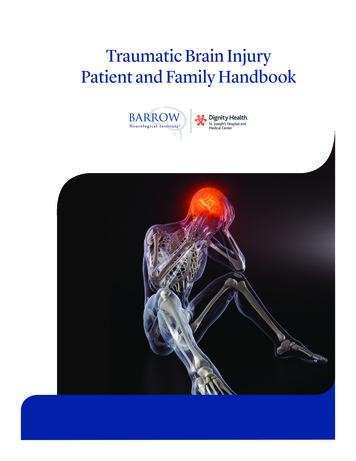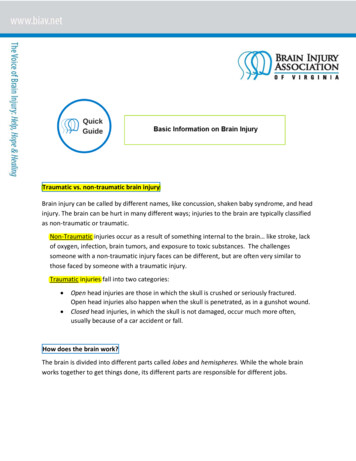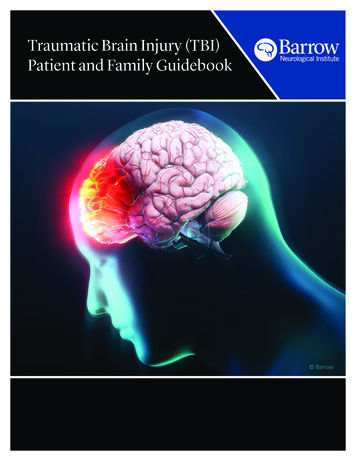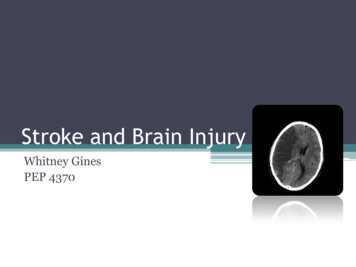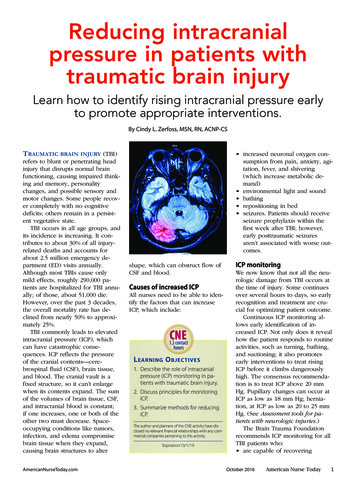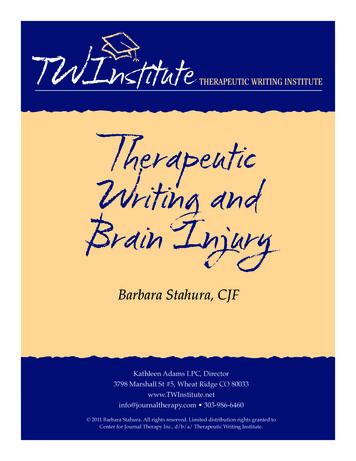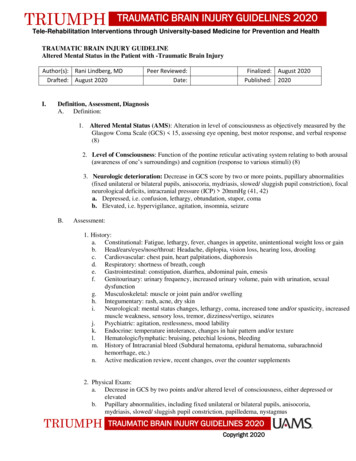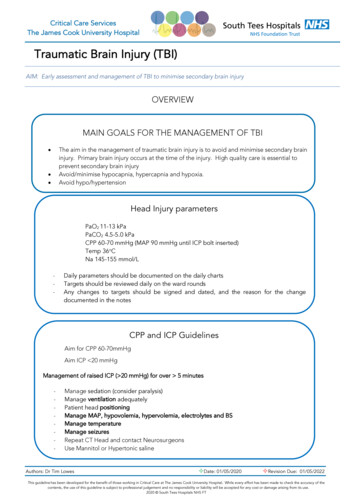
Transcription
Traumatic Brain Injury (TBI)AIM: Early assessment and management of TBI to minimise secondary brain injuryOVERVIEWMAIN GOALS FOR THE MANAGEMENT OF TBI The aim in the management of traumatic brain injury is to avoid and minimise secondary braininjury. Primary brain injury occurs at the time of the injury. High quality care is essential toprevent secondary brain injuryAvoid/minimise hypocapnia, hypercapnia and hypoxia.Avoid hypo/hypertension Head Injury parametersPaO2 11-13 kPaPaCO2 4.5-5.0 kPaCPP 60-70 mmHg (MAP 90 mmHg until ICP bolt inserted)Temp 36oCNa 145-155 mmol/L-Daily parameters should be documented on the daily chartsTargets should be reviewed daily on the ward roundsAny changes to targets should be signed and dated, and the reason for the changedocumented in the notesCPP and ICP GuidelinesAim for CPP 60-70mmHgAim ICP 20 mmHgManagement of raised ICP ( 20 mmHg) for over 5 minutes-Manage sedation (consider paralysis)Manage ventilation adequatelyPatient head positioningManage MAP, hypovolemia, hypervolemia, electrolytes and BSManage temperatureManage seizuresRepeat CT Head and contact NeurosurgeonsUse Mannitol or Hypertonic salineAuthors: Dr Tim Lowes²Date: 01/05/2020²Revision Due:01/05/2022This guideline has been developed for the benefit of those working in Critical Care at The James Cook University Hospital. While every effort has been made to check the accuracy of thecontents, the use of this guideline is subject to professional judgement and no responsibility or liability will be accepted for any cost or damage arising from its use.2020 South Tees Hospitals NHS FT
IntroductionThe aim in the management of traumatic brain injury is to avoid and minimise secondary brain injury. Primary braininjury occurs at the time of the injury. High quality care is essential to prevent secondary brain injury. Maintaining an adequate Cerebral Perfusion Pressure along with adequate oxygenation is central to theprevention of secondary injury. Cerebral perfusion pressure (CPP) Mean arterial pressure (MAP) – intracranial pressure (ICP). Secondary brain injury may therefore occur as an increase in ICP and/or a decrease in blood pressureRaised ICP is associated with: Low PaO2 and/or High PaCO2 Increased cerebral oxygen consumption (fitting, pyrexia, hyperglycaemia) Obstruction to venous drainage (head position, coughing, tube ties) Cerebral oedema (typically peaks in injured brain cells at 72hrs) Expanding intracerebral, subdural or extradural haematoma. Hydrocephalus (outflow obstruction in traumatic SAH)If the ICP is elevated (Normal ICP is 0-10 mmHg, ICP 20 mmHg for more than 5 mins is abnormal), cerebral blood flowmay be compromised even with a normal blood pressure. A single, short period of hypotension (MAP 70mmHg) isassociated with a worse outcome.Cerebral perfusion is autoregulated in health to maintain constant cerebral blood flow within a wide range of bloodpressure. In brain injury (e.g. trauma, infection, bleeding) this autoregulation may be lost. When this happens,hypertension may conversely lead to an increase in intracranial blood volume in normal brain, and an increased ICP andreduced perfusion of the injured brain.The aim is to avoid hypo/hypertension prior to ICP monitoring and then to optimise ICP and MAP to achieve asatisfactory CPP (see CPP & ICP guidelines below).PaO2 and PaCO2 also affect cerebral blood flow. Cerebral blood vessels dilate with increasing PaCO2 or decreasingPaO2 which leads to an increase in intracranial blood volume, increased intracranial pressure and reduced cerebralperfusion pressure. Cerebral blood vessels vasoconstrict with decreasing PaCO2, which will reduce intracranial volume.Unfortunately, cerebral vasoconstriction will reduce cerebral perfusion unless blood pressure is increased.The aim is to avoid/minimise hypocapnia, hypercapnia and hypoxia.Authors: Dr Tim Lowes²Date: 01/05/2020²Revision Due:01/05/2022This guideline has been developed for the benefit of those working in Critical Care at The James Cook University Hospital. While every effort has been made to check the accuracy of thecontents, the use of this guideline is subject to professional judgement and no responsibility or liability will be accepted for any cost or damage arising from its use.2020 South Tees Hospitals NHS FT
Initial management of Traumatic Brain Injury1.ABCDE assessment and management2.CT scan if stable and no life-threatening injury requiring immediate surgery3.Discuss with neurosurgeons:§Theatre, e.g., evacuation of haematoma, etc.§Critical Care: ICP monitoringABCDE assessment and managementAirwayThe first priority must always be to secure, maintain and protect the airway.Cervical spine injury should be assumed to be present.Indications for intubation and ventilation after head injury: Immediately: Coma (not obeying, speaking or eye opening), i.e., GCS 9 Loss of protective laryngeal reflexes (pooling secretions/no swallowing) Hypoxaemia (PaO2 13 kPa on oxygen 15 l/min and reservoir bag) Hypercarbia (PaCO2 6 kPa) Spontaneous hyperventilation (PaCO2 4.0 kPa) Respiratory arrhythmiaBefore transferring out of ED (to CT/theatre/ICU: Deteriorating or fluctuating consciousness (drop on GCS 2 points) Drop in motor score 1 point Bilateral fractured mandible or difficulty with airway maintenance Copious bleeding into mouth SeizuresAuthors: Dr Tim Lowes²Date: 01/05/2020²Revision Due:01/05/2022This guideline has been developed for the benefit of those working in Critical Care at The James Cook University Hospital. While every effort has been made to check the accuracy of thecontents, the use of this guideline is subject to professional judgement and no responsibility or liability will be accepted for any cost or damage arising from its use.2020 South Tees Hospitals NHS FT
BreathingAssess adequacy of ventilation clinically and by arterial blood gas analysis. Aim for PaO2 11-13kPa (higher than normalICU patient in order to increase brain tissue oxygenation and reduce chance of unintentional hypoxaemia), PaCO2 4.5 –5.0 kPa. Avoid hypocapnia (PaCO2 4.0 kPa). Note: EtCO2 will be approx. 0.7 kPa lower than arterial (if the bloodpressure is normal and in the absence of significant lung pathology).CirculationIf GCS 8, assume elevated ICP (20-30 mmHg) and maintain MAP 80-90 mmHg to ensure CPP 60-70 mmHg. Ifeuvolaemic, use vasopressors/inotropes (noradrenaline or ephedrine 3mg boluses) to maintain MAP if needed (cautionrequired in elderly or those with heart disease).An isolated head injury is rarely the cause of shock, especially in adults. Look for signs of hypovolaemia, (tachycardia,pulse pressure variation with respiration/ventilation, capillary refill, oliguria). Actively look for a source of bleeding(multiple fractures, thoracic, abdominal, pelvic haemorrhage) and consider general surgical input. A patient in persistentshock despite fluid resuscitation must not be transported to CT or critical care until the source has been identified andcontrolled as part of the resuscitation.Use 0.9% sodium chloride initially, or blood/FFP as required to correct coagulopathy.(Hartmann’s or dextrose solutions) and albumin (SAFE trial).Avoid hypotonic fluidsIf persistent hypotension despite adequate filling (clinical or echo assessment), consider myocardial contusion,tamponade, pneumothorax, high spinal cord injury, coning.Catheterise the bladder and measure urine output.ICU ManagementInitial stabilisation in critical careVentilationPaO2 11-13kPa, PaCO2 4.5-5.0kPaVT 6-8ml/kg, f 12, I:E ratio 1:1.5-1:2, PEEP 5-10cmH2OSedationPropofol 2-4mg/kg/hr; Alfentanil 10-50mcg/kg/hr titrated to effectAtracurium bolus/infusion if indicatedCirculationCPP 60-70mmHg (MAP 80-90mmHg until ICP bolt)MonitoringA-line, CVP, ECG, temp, end tidal CO2InvestigationsABGs, U&E, FBC, Coagulation screen, G SAuthors: Dr Tim Lowes²Date: 01/05/2020²Revision Due:01/05/2022This guideline has been developed for the benefit of those working in Critical Care at The James Cook University Hospital. While every effort has been made to check the accuracy of thecontents, the use of this guideline is subject to professional judgement and no responsibility or liability will be accepted for any cost or damage arising from its use.2020 South Tees Hospitals NHS FT
Reassess ventilation-Initial VT 6-8ml/kg-Ideally use a volume control mode to ensure consistent minute ventilation (e.g. SIMV) to regulate PaCO2 or useBIPAP with close volume/EtCO2 alarm limits-If plateau/peak pressure is high, consider reduction in tidal volume or BIPAP-If BIPAP is used, set alarm limits for minute volume close to desired target to detect varying minute volume dueto changes in compliance.-Monitor ETCO2 (with alarm limits set to maintain desired range)-Use rate to control PaCO2Use FiO2 /PEEP to control PaO2. A minimum of 5 cmH2O PEEP should be used to reduce atelectasis as for any otherICU patient. Up to 12 cmH2O PEEP can be used in head injured patients with minimal effect on ICP, providing that thepatient is euvolaemic and does not have markedly reduced lung compliance (transmission of increased intrathoracicpressure to brain).If PaO2 11 kPa despite FiO2 0.5 and PEEP 12 cmH2O discuss with consultant after appropriate assessment. Carefulproning may be preferable to APRV and sustained PHigh.Reassess circulation-Aim for CPP 60-70mmHg, maintain MAP 90 mmHg until ICP monitor inserted-Is the patient adequately filled? Assess clinically and/or with Echo/Cardiac output monitoring.-Rule out ongoing haemorrhage - Consider chest, abdomen, pelvis, long bone fractures-Seek orthopaedic or general surgical advice-Inotropic support as indicated-ICP monitoringAll patients with GCS 8 and traumatic brain injury should have an ICP bolt inserted by the neurosurgeons unless theinjury is so severe that active management is considered futile or the CT appearance does not correlate with the clinicalpicture (e.g. suspicion of seizure activity/alcohol/drugs affecting GCS).If ICP 20mmHg see ICP guidelinesAuthors: Dr Tim Lowes²Date: 01/05/2020²Revision Due:01/05/2022This guideline has been developed for the benefit of those working in Critical Care at The James Cook University Hospital. While every effort has been made to check the accuracy of thecontents, the use of this guideline is subject to professional judgement and no responsibility or liability will be accepted for any cost or damage arising from its use.2020 South Tees Hospitals NHS FT
SedationAvoid coughing and straining. Ensure adequate sedation prior to intervention (e.g. suctioning) and avoid clusteringactivities together-Propofol & AlfentanilStart initially with propofol 2-4mg/kg/hr and alfentanil 10-30mcg/kg/hr.Reduce the dose in hypothermic patients (1-3mg/kg/hr) to avoid propofol infusion syndrome.-MidazolamMidazolam 0.1-0.2mg/kg/hr may be added to propofol if sedation is inadequate at maximum doses-Clonidine0.5-2mcg/kg/hr may be added to sedation when weaning in hypertensive patients.-RemifentanilRemifentanil can be used short term when weaning towards extubation (See separate guidelines).Positioning-Head up 30 degreesNeutral head positionNo obstruction to venous return (e.g. ties/collar)Spinal clearance (see separate guidelines) at earliest opportunity: Tape and sandbags with bed flat and headup tilt (C-collar for log roll/transfer only)Osmolality-Aim 300-320 mOsmol/L if raised ICP.Aim for Na 145-150 mmol/L (alternate 0.9% saline and 1.26% NaHCO3 to avoid hyperchloraemic acidosis)If ICP raised, aiming for Na 150-155 mmol/L may be appropriate.Avoid hypotonic fluid (Hartmann’s, 0.18% NaCl/5% Glucose etc)Check U&Es and Osmolality every 12hrs initially and 2hrs after giving Mannitol or Hypertonic saline.Glucose-Normal ICU glycaemic control: blood sugar 6.0 – 10.0GI tract-Enteral feed immediately.Gastric protection as per unit protocolRoutine ICU laxative protocolAuthors: Dr Tim Lowes²Date: 01/05/2020²Revision Due:01/05/2022This guideline has been developed for the benefit of those working in Critical Care at The James Cook University Hospital. While every effort has been made to check the accuracy of thecontents, the use of this guideline is subject to professional judgement and no responsibility or liability will be accepted for any cost or damage arising from its use.2020 South Tees Hospitals NHS FT
Temperature-Avoid hyperthermia: cool if needed, to maintain temperature 36 C (this ensures temperature does not go above37 C)DO NOT use Prophylactic Hypothermia (POLAR – Glasgow Outcome Score Extended at 6 months identical andhigher pneumonia and ventilator days in hypothermia group.Consider Therapeutic Hypothermia (34-36 C) for refractory high ICP – (Eurotherm-3235 suggested highermortality and worse Outcome Scores in hypothermia group but other studies suggest benefit in refractory highICP)Seizures-Consider prophylaxis in high risk patients (e.g., known epilepsy/temporal lobe damage/depressed skullfracture)Only use within first 7 days of injury (unless treating seizures)Load with Phenytoin 18mg/kg iv (at 50mg/kg/min) then 100mg iv TDS for 7 daysOr Levetiracetam 1g iv then 1g BD iv for 7 daysLMWH-Discuss with surgeonsConsider LMWH DVT prophylaxis after 72hrs depending on pathology. All patients should have mechanical calfcompression from admissionPrimary brain injury may cause hypercoagulability and with immobilisation VTE risk is increased (25% incidenceeven with calf compression). Age, subarachnoid blood and other injuries further increase risk.Low dose anticoagulation has the potential to cause significant intracranial haemorrhage expansion, so balanceof risk must be assessed.Antibiotics-Culture blood, sputum, urine if pyrexialTreat established or clinically significant infection aggressivelyConsider prophylaxis for ICP bolts/EVDs and skull fractures (Ceftriaxone 1g IV od)Head Injury parametersPaO2 11-13 kPaPaCO2 4.5-5.0 kPaCPP 60-70 mmHg (MAP 90 mmHg until ICP bolt inserted)Temp 36oCNa 145-155 mmol/L-Authors: Dr Tim LowesDaily parameters should be documented on the daily chartsTargets should be reviewed daily on the ward roundsAny changes to targets should be signed and dated, and the reasonfor the change documented in the notes²Date: 01/05/2020²Revision Due:01/05/2022This guideline has been developed for the benefit of those working in Critical Care at The James Cook University Hospital. While every effort has been made to check the accuracy of thecontents, the use of this guideline is subject to professional judgement and no responsibility or liability will be accepted for any cost or damage arising from its use.2020 South Tees Hospitals NHS FT
CPP GuidelinesAim for CPP 60-70mmHgIf ICP 20mmHg follow ICP guidelines belowIf MAP inadequate to maintain CPP exclude and treat: Hyovolaemia (including cerebral salt wasting and cranial diabetes insipidus)SepsisCardiac dysfunction (primary or neurogenic)Then use inotropes/vasopressors as indicated to achieve MAP (usually noradrenaline /- dobutamine)Consider echocardiography /- invasive cardiac output monitoring if: Acute or pre-existing cardiac disease Hypotension with high CVP Oliguria with high CVP Severe sepsis Pulmonary oedema Cardiac contusion High inotropic requirements, cardiac disease, over 50 yearsDiscuss with consultant: Patients with significant heart disease, acute lung injury, sepsis, failure to respondAuthors: Dr Tim Lowes²Date: 01/05/2020²Revision Due:01/05/2022This guideline has been developed for the benefit of those working in Critical Care at The James Cook University Hospital. While every effort has been made to check the accuracy of thecontents, the use of this guideline is subject to professional judgement and no responsibility or liability will be accepted for any cost or damage arising from its use.2020 South Tees Hospitals NHS FT
ICP GuidelinesManagement of raised ICP ( 20 mmHg) for over 5 minutesExclude or manage:-Inadequate sedation (consider paralysis)-Inadequate ventilation or aggressive hyperventilation-Patient head positioning (30 degrees head up and head neutral)-Inadequate MAP (causing cerebral vasodilatation) or increasing MAP (in patients with loss of autoregulationmay also cause cerebral dilatation)-Seizures (EEG may be required)-Pyrexia-Hypo/Hypervolaemia (or Hyponatraemia)-EVD Blocked? Discuss with neurosurgeons and consider withdrawing 5 mL aliquotsIf ICP remains elevated 20 mmHg (or dilated pupil) urgently repeat CT Head. If in doubt, discuss with NeurosurgeonsPrior to CT Temporary hyperventilation to maintain PaCO2 3.5- 4 kPa and Increase MAP by 10mmHg to maintain same flow through vasoconstricted cerebral vessels.Management of raised ICP with Hypertonic Saline or MannitolOnly if Na 155 & Osmolality 320 mosm/L).They both work by increasing plasma osmolality to ‘draw’ fluid from cerebral oedema, and also reduce bloodviscosity to improve microcirculatory blood flow.Mannitol will usually cause a delayed diuresis. 5% saline - 2mL/kg (e.g. 160 mL for 80kg patient) slow iv push centrally or via large vein 10mL 30% NaCl upto 60mL with water 5% 10% or 20% Mannitol – 0.25-0.5g/kg (IBW) (e.g. 100-200mL of 20% or 200-400mL of 10% for 80kg patient)over 15 mins.After CT Urgent D/W Neurosurgeons – Requirement for Surgery?Authors: Dr Tim Lowes²Date: 01/05/2020²Revision Due:01/05/2022This guideline has been developed for the benefit of those working in Critical Care at The James Cook University Hospital. While every effort has been made to check the accuracy of thecontents, the use of this guideline is subject to professional judgement and no responsibility or liability will be accepted for any cost or damage arising from its use.2020 South Tees Hospitals NHS FT
If ICP remains elevated and Neurosurgeons decide for Medical Management only: Increase sedation & paralyse (if not already) Aim for temp 36oC and consider lowering to 34-36oC in refractory cases. Consider Thiopentone bolus (3-5mg/kg); alternatively consider Ketamine bolus (1-2mg/kg) if BP tends to dropwith sedation. Ketamine has been shown to reduce ICP, although a delayed increase may be seen. Consider boluses of lignocaine 1% over 5 mins (0.1 ml/kg) prior to suction/physioRaised ICP despite ALL Medical Management above: Thiopentone coma – (BTF Guidelines 2016 Level IIB recommendation to control elevated ICP refractory tomaximum medical treatment). See below – there is little evidence to recommend it & discuss with Consultant Decompressive craniectomy is not recommended by BTF (DECRA – More unfavourable outcomes, althoughlowers ICP and fewer ICU days, RESCUE-ICP – Identical (27%) patients in Medical management group with lowermoderate disability or better. Decompressive Craniectomy resulted in fewer deaths but more patients withUpper severe disability (unable to leave home unassisted) or worse.Large frontal-temporo-parietal DC is recommended if done - note 20% incidence of complications (including death)associated with subsequent cranioplasty.Thiopentone comaThere is little evidence to support its use despite the theoretical advantages of a reduction in cerebral electrical activity,cerebral oxygen consumption, production of excitatory amino acids and lipid peroxidation. Although it may reduce ICPit can also reduce MAP.A thiopentone bolus (3-5mg/kg) should be used as a therapeutic trial first, if there is no reduction in ICP (ensuring BP ismaintained), continued infusion is not advised.Cautions and contraindications:Patient with hepatic or renal dysfunctionElderlyMyastheniaPorphyria-Eisenberg Protocol for Thiopentone Coma-Thiopentone 10mg/kg over 30 mins then 5mg/kg/hr (IBW) for 3 hrs then 1mg/kg maintenance.Titrate dose using BIS and aim for 20-30.Thiopentone may be given peripherally if necessary. It is alkaline, so do not give anything else with it as mayprecipitate with other solutions. (Hazard Label).Observe intravenous access sites as extravasation may lead to tissue necrosis.Authors: Dr Tim Lowes²Date: 01/05/2020²Revision Due:01/05/2022This guideline has been developed for the benefit of those working in Critical Care at The James Cook University Hospital. While every effort has been made to check the accuracy of thecontents, the use of this guideline is subject to professional judgement and no responsibility or liability will be accepted for any cost or damage arising from its use.2020 South Tees Hospitals NHS FT
Document DetailsTitleTraumatic Brain InjuryMain points the document coversManagement in Critical CareWho is the document aimed at?Critical Care staffAuthorDr Tim LowesApproval processApproved byCritical care guidelines groupEffective fromImmediatelyCategoryCritical Care services JCUHSub-categoryNeurosciencesReview date)1/05/2022Document LinksRequired by CQCGPICSRequired by NHSLAYesOtherExternal references used1.2.3.4.5.6.7.Carney N et al. Guidelines for the management of severe traumatic brain injury, fourth edition. 2016. Availableat: the-management-of-severe-tbi-4th-ed#/. Accessed Apr25 2020.Cooper DJ et al. Decompressive Craniectomy in Diffuse Traumatic Brain Injury (DECRA). NEJM 2011; 364:1493-1502.Hutchinson PJ et al. Trial of Decompressive Craniectomy for Traumatic Intracranial Hypertension (RESCUEICP). NEJM 2016; 375: 1119-1130.Cooper DJ et al. Effect of Early Sustained Prophylactic Hypothermia on Neurologic Outcomes Among Patientswith Severe Traumatic Brain Injury (POLAR). JAMA 2018; 320: 2211-2220.Andrews PJD et al. Hypothermia for Intracranial Hypertension after Traumatic Brain Injury (Eurotherm3235).NEJM 2015; 373: 2403-2412.Yerram, S et al. Seizure prophylaxis in the neuroscience intensive care unit. J Intensive Care 6, 17 (2018).https://doi.org/10.1186/s40560-018-0288-6. Currently not enough corroborative evidence to support use oflevetiracetam over phenytoin for prevention of seizures in TBI.Schwimmbeck F et al. Hypertonic Saline Versus Mannitol for Traumatic Brain Injury. J Neurosurg Anesthesiol2019; Sep 20. doi: 10.1097/ANA.0000000000000644.12 RCTs with 464 patients. There are indications that HSmight be superior to mannitol (non-significant trend) in the treatment of TBI-related raised ICP; however, thereare insufficient data to reach.Amendments HistoryNoDateAmendment123Authors: Dr Tim Lowes²Date: 01/05/2020²Revision Due:01/05/2022This guideline has been developed for the benefit of those working in Critical Care at The James Cook University Hospital. While every effort has been made to check the accuracy of thecontents, the use of this guideline is subject to professional judgement and no responsibility or liability will be accepted for any cost or damage arising from its use.2020 South Tees Hospitals NHS FT
The aim in the management of traumatic brain injury is to avoid and minimise secondary brain injury. Primary brain injury occurs at the time of the injury. High quality care is essential to prevent secondary brain injury Avoid/minimise hypocapnia, hypercapnia and hypoxia. Avoid hypo/hypertension Head Injury parameters PaO 2 11-13 kPa
